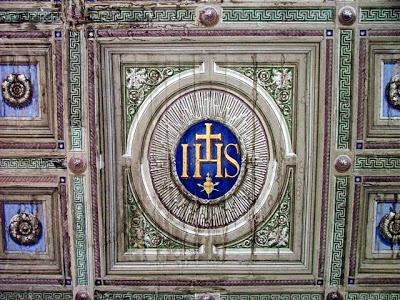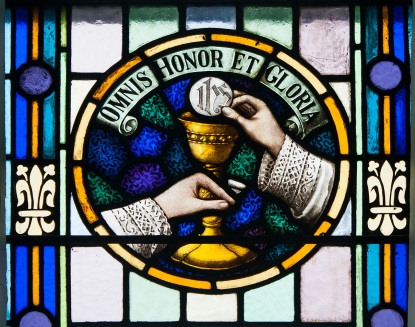
St. Bernardine of Siena (1380-1444) painted a wooden tablet with the Monogram of the Holy Name of Jesus - Â ''IHS'' - surrounded by the rays of the sun, to help spread the devotion far and wide. In the centuries that followed, it became common to see similar representations of this Monogram depicted in sacred art, architecture, vessels and vestments. With a cross mounted above the central letter ''H'', this eventually became the emblem of the Jesuits. Â
The Traditional Calendar today celebrates the Feast of the Most Holy Name of Jesus. From the earliest days of the Church, Catholics have reverenced, and even prayed, the Holy Name of Jesus as a foundational devotion.
The closer one draws to Our Lord, the more one loves His beautiful and holy Name. This is more true than even the love one has for a spouse, because the Name of Jesus bears and expresses infinite depth. In the presence of this Name, we wish to become consumed by the eternal One, Who bears It.Â
St. Paul proclaimed: ''For which cause God also hath exalted Him, and hath given Him a name which is above all names: That in the name of Jesus every knee should bow, of those that are in heaven, on earth, and under the earth: and that every tongue should confess that the Lord Jesus Christ is in the glory of God the Father'' (Philippians 2:9-11).
Again, in Acts 4:12, we read: ''Neither is there salvation in any other. For there is no other name under heaven given to men, whereby we must be saved.''
The very name of Jesus expresses to us the infinite mystery of the Second Person of the Blessed Trinity. For that reason, the Catechism of the Catholic Church reminds us that the ''invocation of the Holy Name of Jesus is the simplest way of praying always'' (CCC 2668). Praying the Holy Name of Jesus was an indulgenced prayer for long periods of Church history. If ever one finds it hard to pray, or even if one is blessed with the desire to pray, it is a good practice to simply repeat the Holy Name with as much devotion as one can muster. Â
When I first became a Catholic in 1993, I noticed that there were a number of older Catholics in the parish who gently bowed their heads whenever the Holy Name of Jesus was mentioned during Holy Mass.
As the years went by, this practice became less common until Angie and I began to attend only the Traditional Latin Mass several years ago. In the Traditional Latin Mass, most people - in all ages of the congregation - continue this time-honoured practice.
I say time-honoured, because the 2nd Council of Lyons, held at the behest of Pope Gregory X in 1274 A.D., formally wrote the custom of bowing the head at the name of Jesus into the law of the Church.
That sacred Council ordered: ''Those who assemble in church should extol with an act of special reverence that Name which is above every name, than which no other under Heaven has been given to men, in which believers must be saved, the Name, that is, of Jesus Christ, Who will save His people from their sins. Each should fulfil in himself that which is written for all, that at the Name of Jesus every knee should bow; whenever that glorious Name is recalled, especially during the Sacred Mysteries of the Mass, everyone should bow the knees of his heart, which he can do even by a bow of his head.''
I actually owe my own practice of bowing my head at the mention of the Holy Name of Jesus to a small Irish boy that was interviewed on BBC's Songs of Praise programme sometime around 20 years ago.
I had, at that time, been a Catholic for just a couple of years and, as mentioned above, was aware that a few older Catholics were bowing their heads during Holy Mass. When this boy was speaking, very naturally, about his love for Jesus during this TV-show, he bowed his head in a manner that was as touching as it was natural. It was evident that this was so much part of the lad's daily practice that it was completely second nature to him.
From that day forward, I endeavoured to bow my own head whenever the Holy Name was mentioned in homilies and so forth during Mass.
As with any pious practices that are embraced as much by the heart as the limbs, this gradually became second nature to me also; both during the Sacred Liturgy and at other times when I hear the Most Holy Name being mentioned outside of Mass. Even when I say the Holy Name out loud myself, I generally bow the head gently. It is a consoling practice that has become something almost unnoticed by myself; and yet to omit it would register in my soul with a sense of discomfort. Thus, when I speak of the practice becoming unnoticed as second nature, this is not the same as to speak of it as unwilled. Rather, its practice makes it become so much part of the will that, eventually, it no longer requires conscious effort.Â

A good Catholic lady recently expressed her sadness to me that so few Catholics today bow their heads when the Lord's Name is spoken during Mass. That lady is right: we should be concerned about the loss of this practice and all that it signifies. Perhaps one aspect of this loss is down to that widespread collapse in orthodox catechesis that has sadly typified the last five decades in the Church. There are many well-intentioned younger Catholics who have never even heard of, much less encountered, this pious practice.
And yet it is worth noting that this practice is even pointed out in the latest General Instruction on the Roman Missal (GIRM). This explicitly teaches: ''A bow signifies reverence and honour shown to the persons themselves or the signs that represent them. There are two kinds of bows: a bow of the head and a bow of the body...A bow of the head is made when the three Divine Persons are named together and at the names of Jesus, of the Blessed Virgin Mary, and of the Saint in whose honour Mass is being celebrated'' (GIRM 275).
Going forward there are several practical things that we can all do to assist the recovery of this practice in order to deepen the honour given to the Most Holy Name of Jesus: praying the Holy Name over and over ourselves at some point each day with loving devotion; cultivating the practice of reverently bowing our own heads until this becomes second nature to us; passing this information on through sermons, newsletters, blogs, catechetical sessions and conversations with others; deciding to tell our own friends about it in celebration of this feast.
Let us conclude with the Offertory prayer from today's Traditional Latin Mass and Psalm 85: I will praise Thee, O Lord my God, with my whole heart, and I will glorify Thy Name forever; for Thou, O Lord, art sweet and mild, and plenteous in mercy to all that call upon Thee. Alleluia.



